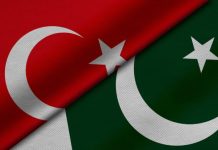HELSINKI: Finland’s much-delayed Olkiluoto 3 (OL3) nuclear reactor, Europe’s largest, began regular output early on Sunday, its operator said, boosting energy security in a region to which Russia has cut gas and power supplies.
Nuclear power remains controversial in Europe, primarily due to safety concerns, and news of OL3’s start-up comes as Germany on Saturday switched off its last three remaining reactors, while Sweden, France, Britain and others plan new developments. OL3’s operator Teollisuuden Voima (TVO), which is owned by Finnish utility Fortum and a consortium of energy and industrial companies, has said the unit is expected to meet around 14 percent of Finland’s electricity demand, reducing the need for imports from Sweden and Norway. The new reactor is expected to produce for at least 60 years, TVO said in a statement on Sunday after completing the transition from testing to regular output.
“The production of Olkiluoto 3 stabilizes the price of electricity and plays an important role in the Finnish green transition,” TVO Chief Executive Jarmo Tanhua said in the statement.
Construction of the 1.6 gigawatt (GW) reactor, Finland’s first new nuclear plant in more than four decades and Europe’s first in 16 years, began in 2005. The plant was originally due to open four years later, but was plagued by technical issues.
OL3 first supplied test production to Finland’s national power grid in March last year and was expected at the time to begin regular output four months later, but instead suffered a string of breakdowns and outages that took months to fix.
Russia’s power exports to Finland ended last May when Russian utility Inter RAO said it had not been paid for the energy it sold, a consequence of the widening gulf between Moscow and Europe over the war in Ukraine.
Russian state export monopoly Gazprom shortly after ended shipments of natural gas to the Nordic nation.
Meanwhile, Germany switched off its last three nuclear reactors on Saturday, exiting atomic power even as it seeks to wean itself off fossil fuels and manage an energy crisis caused by the war in Ukraine. While many Western countries are upping their investments in atomic energy to reduce their emissions, Germany brought an early end to its nuclear age.
It’s “the end of an era,” the RWE energy firm said in a statement shortly after midnight confirming the three reactors had been disconnected from the electricity grid.
Europe’s largest economy has been looking to leave behind nuclear power since 2002, but the phase-out was accelerated by former chancellor Angela Merkel in 2011 after the Fukushima nuclear disaster in Japan.
The exit decision was popular in a country with a powerful anti-nuclear movement, stoked by lingering fears of a Cold War conflict and atomic disasters such as Chernobyl in Ukraine.
“The risks of nuclear power are ultimately unmanageable,” said Environment Minister Steffi Lemke, who this week made a pilgrimage to the ill-fated Japanese plant ahead of a G7 meeting in the country.
Anti-nuclear demonstrators took to the streets in several German cities to mark the closures.
Greenpeace, at the heart of the anti-nuclear movement, organized a celebratory party at the Brandenburg Gate in Berlin.
“We are putting an end to a dangerous, unsustainable and costly technology,” said Green MP Juergen Trittin.
In front of the Brandenburg Gate, activists symbolically slayed a model dinosaur.
Initially planned for the end of 2022, Germany’s nuclear exit was delayed as Russian gas supplies dwindled. Germany, the largest emitter in the European Union, also powered up some of its mothballed coal-fueled plants to cover the potential gap left by gas.




